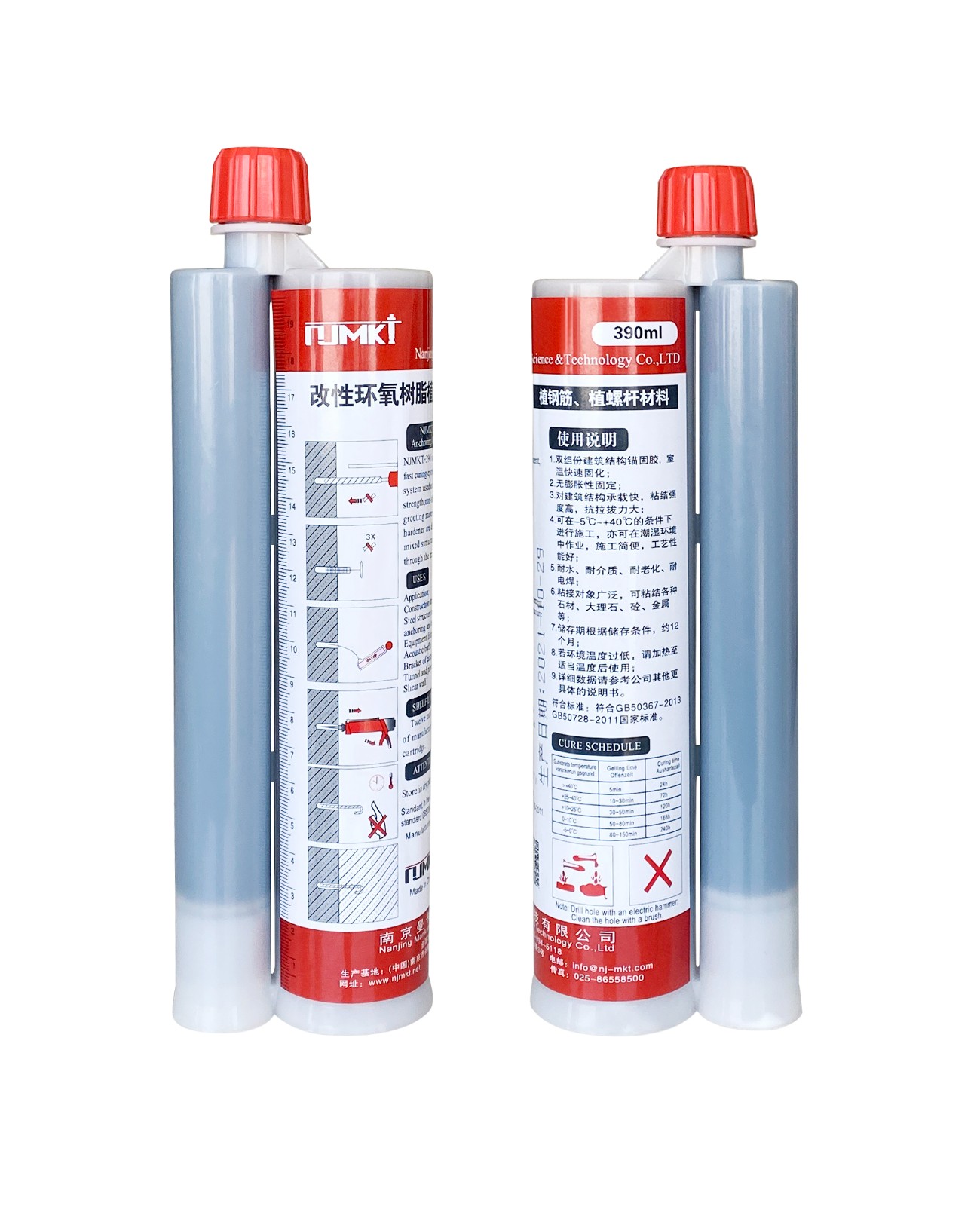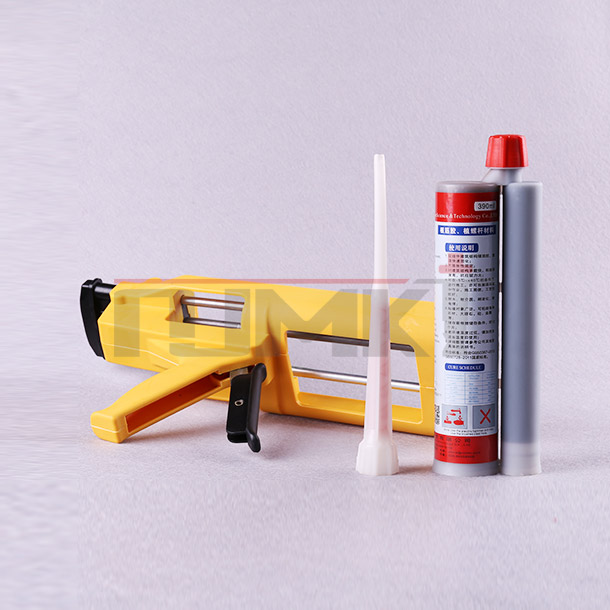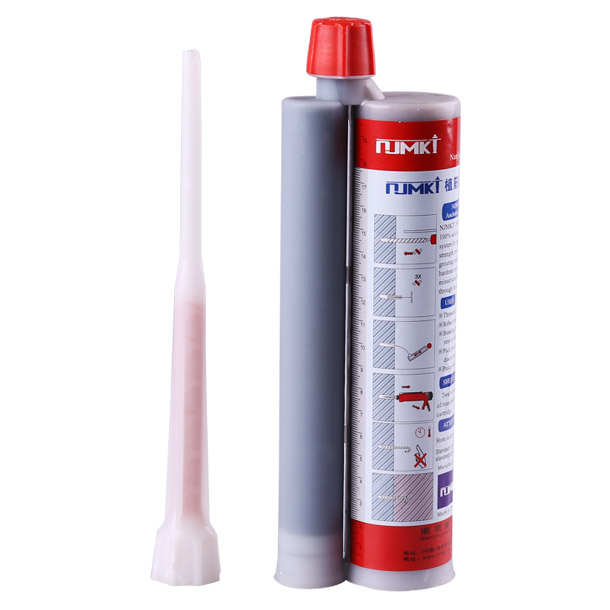Main Components: Modified epoxy resin, nanomaterials, other additives
Component A: Component B = 3:1
Features:
Two-component anchoring adhesive, fast-cure, epoxy-based anchoring adhesive, nearly odorless, non-toxic, no drip, no sag, and easy clean up
Quick load-bearing after cure, high initial bonding strength and anti-pulling capacity
Strong anchorage bonding strength achieves the effect of embedded parts
Higher strength than the concrete around it after cure
Compared with other mechanical or chemical anchor, it has a larger load-bearing capacity
There is almost no shrinkage during curing process
No expansion stress, provide the best spacing and edge distance
Good resistance to weather, high temperature, age, chemical corrosion, welding, seismic, flame, etc.
Fast and easy dispensing by special double spiral mixing nozzle to ensure accurate mixing proportion
When properly mixed, adhesive will be an even color to injection for use

● Suitable for anchor and rebar embedding in all construction base materials, such as cracked and uncracked concrete, granite, etc.
● It almost can be applied to any holes with different diameter and depth
● Wide working temperature range: -5℃~ 40℃, available in all environmental/weather working conditions, including dry concrete, water-saturated and water-filled holes, and underwater environment (choose NJMKT special underwater adhesive), long-term stable loading performance
● NJMKT adhesive specialized for low temperature can still keep a perfect performance in the temperature of -5℃, you can choose our special low temperature adhesive depending on your installation condition
● Suitable for horizontal, vertical and overhead applications
● Suitable for static and seismic loading conditions and heavy-load fixings and fastenings
● Widely used for curtain wall, guard rail, sound barrier, bridge beam, equipment fixing, seismic strengthening, repairing and retrofitting and bracing of reinforced concrete buildings, rebar doweling, connection of post-installed rebars and anchors, etc.
undefinedimg src="/uploadfile/20161103/1478138897499220.jpg" title="NJMKT NJMKT-390 Anchorage Adhesive" alt="NJMKT NJMKT-390 Anchorage Adhesive""/undefined
Operating environment:
● Dry condition
Installation

1. Drill the hole to proper depth and diameter per specifications using drill systems.
2. Clean the hole using brush and compressed air for three times.
3. Use specialized cartridge or nozzle, discard the first injections until an even color is achieved. Inject adhesive until up to 2/3 depth of drilled hole.
4. Insert the rebar/anchor/bolt/rod slowly into the bottom of the hole clockwise.
5. Do not knock or strike the steel element during cure time. Adhesive must be fully cured before applying any load or torque.
6. Finish installation and continue the follow-up construction and apply the load.
Packing
Packing: 390ml cartridge (20 pieces/barrel)
Storage:
Shelf life: At least 12 months from date of manufacture in unopened container when store in dry and well-ventilated place. Please store in ambient temperature from 5 ℃ to 40 ℃, away from open flame, heating devices
Adhesive specialized for low temperature can be stored in ambient temperature from -5 ℃ to 40 ℃
Handle with care, protect from rain, sunlight and place upward during loading and unloading transportation
Caution
Mix the adhesive well according to its weight proportion strictly
Construction crew should take steps of protective measures to keep it from eyes
Remaining adhesive cannot be poured into original barrels
Cartridge cap design is available for several times to use the total amount of adhesive, avoid wasting
| Cure Schedule | ||
| Base material temperature [°C] | Gel time [minute] | Cure time [day] |
| -5°C ~ 0°C | 80-150 | 10 |
| 0°C ~ 10°C | 50-80 | 7 |
| 10°C ~ 25°C | 30-50 | 5 |
| 25°C ~ 40°C | 10-30 | 3 |
| ≥40°C | 5 | 1 |

Technical specification:MK-390ml for threaded rod
| Rod diameter( mm) Concrete C30 | M8 | M10 | M12 | M16 | M20 | M24 | M30 |
| Drilled diameter | 10 | 12 | 14 | 18 | 24 | 28 | 35 |
| Drilled depth | 80 | 90 | 110 | 145 | 180 | 220 | 280 |
| The average tension failure KN steel grade 6.8 | 18.7 | 30.2 | 45.5 | 79.5 | 125.5 | 186.5 | 245.5 |
| Steel grade 8.8 / Stainless steel A4 | 23.5 | 36.8 | 52.9 | 94.1 | 147.0 | 211.7 | 254.5 |
| The average shear failure KN steel grade 6.8 | 11.7 | 18.3 | 26.7 | 48.9 | 75.5 | 108.9 | 171.3 |
| Steel grade 8.8 | 17.5 | 27.8 | 40.5 | 75.3 | 117.6 | 169.4 | 269.3 |
| Stainless steel A4 | 15.4 | 24.4 | 35.4 | 65.9 | 102.9 | 115.9 | 188.3 |
| Design tensile strength KN | 7.7 | 12.0 | 17.2 | 30.6 | 47.9 | 68.9 | 82.8 |
| Design shear strength KN steel grade 6.8 KN | 7.9 | 12.5 | 18.6 | 33.9 | 53.5 | 76.1 | 119.7 |
| Steel grade 8.8 | 11.7 | 18.6 | 27.0 | 50.2 | 78.4 | 113.0 | 179.5 |
| Stainless steel A4 | 8.3 | 13.0 | 190.0 | 35.3 | 55.2 | 86.9 | 140.5 |
| The number of the holes for each adhesive | 86 | 53 | 32 | 15 | 7 | 4 | 2 |
| Rebar | Hole | Eigenvalue of anchorage force | ||||||||||||||||||||
| Dia. | Dia. | |||||||||||||||||||||
| Φ | D | |||||||||||||||||||||
| mm | mm | KN | ||||||||||||||||||||
| 10 | 14 | 24.8 | 26.3 | |||||||||||||||||||
| 12 | 16 | 32.5 | 37.9 | |||||||||||||||||||
| 14 | 18 | 40.9 | 46.7 | 51.6 | ||||||||||||||||||
| 16 | 22 | 54..7 | 61.6 | 67.4 | ||||||||||||||||||
| 18 | 25 | 67. 2 | 74..6 | 82.1 | 85.2 | |||||||||||||||||
| 20 | 28 | 80.2 | 88.2 | 96.3 | 104.3 | 105.2 | ||||||||||||||||
| 22 | 30 | 90.8 | 99.1 | 107.3 | 115.6 | 123.8 | 127.3 | |||||||||||||||
| 25 | 32 | 101.3 | 109.8 | 118.2 | 126.7 | 147.8 | 164.4 | |||||||||||||||
| 28 | 36 | 124.1 | 132.9 | 155.1 | 177.2 | 199.4 | 206.3 | |||||||||||||||
| 32 | 40 | 145.9 | 170.2 | 194.5 | 218.8 | 243.2 | 257.5 | 269.4 | ||||||||||||||
| 36 | 44 | 160.7 | 180.8 | 200.9 | 221.0 | 238.1 | 255.2 | 272.2 | 290.3 | |||||||||||||
| 40 | 48 | 185.3 | 210.3 | 225.3 | 248.2 | 268.2 | 285.2 | 308.2 | 318.1 | 330.1 | ||||||||||||
| Embedment depth L(mm) | ||||||||||||||||||||||
| 100 | 120 | 140 | 160 | 180 | 200 | 220 | 240 | 260 | 280 | 300 | 350 | 400 | 450 | 500 | 550 | 650 | 650 | 700 | 750 | 800 | ||





























































